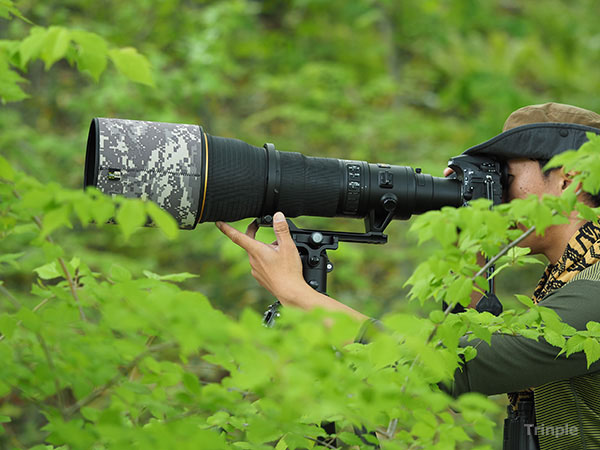中野耕志 | リングプレート
AF-S NIKKOR 800mm f/5.6E FL ED VR
AF-S Teleconverter TC800-1.25E ED

1972年生まれ。
野鳥や飛行機の撮影を得意とし、雑誌や広告を中心に作品を発表。
「Birdscape~鳥のいる風景」、「Jetscape~飛行機の飛ぶ風景」の2大テーマを求めて国内外を飛び回る。
近著に「デジタルカメラによる野鳥の撮影テクニック」(誠文堂新光社)、「デジタルカメラ飛行機撮影術」(アストロアーツ)などがある。
ウェブサイト: www.strix-photography.com
日本写真家協会会員
野鳥撮影の難易度は、対象種の大きさや生態、生息環境などにより大きく異なります。たとえば冬に渡来するハクチョウ類やカモ類、カモメ類などは近距離からの撮影機会が多いため、比較的焦点距離が短く明るいレンズでも十分に撮影することができます。また日中であれば光量も十分なので、シャッター速度に起因するカメラブレに悩まされることもないでしょう。
ところが山の鳥ともなると撮影難易度が格段に上がります。まず被写体が15~30cm程度と小さく、しかも警戒心が強いため近くで撮らせてくれるチャンスは極めて少ないものです。したがって600mmF4や800mmF5.6といった大口径超望遠レンズが必要になってきます。これらのレンズは超望遠レンズとしては「明るい」部類ではありますが、薄暗い林内では露出は厳しいことがほとんどです。もちろんISO感度を上げて対応することもできますが、相手の動きがとまってさえいれば、シャッター速度を遅くしてでもISO感度を下げて、より高品位な撮影を目指したいものです。
野鳥撮影において、ブレによる失敗は2種類の要因が考えられます。ひとつは露光中に相手が動くことによる「被写体ブレ」、もうひとつは露光中にカメラが動くことによる「カメラブレ」です。前者はシャッター速度の管理によってブレ量をコントロールするしかありませんが、後者は撮影機材や撮影方法を改善することでブレを低減もしくは防止することができるのです。
私は現在ニコンのAF-S NIKKOR 800mm f/5.6E FL ED VRをメインレンズとして使用していますが、超高画質を最大限に発揮するためにはブレ防止にとくに気を遣っています。
超望遠レンズは前後に長いわりに、通常使用では雲台に接する部分は三脚座の1点のみなので、見るからにアンバランスです。これではブレを抑えることができません。また純正三脚座の多くは操作性を重視するあまり重心が高く、ブレ防止という意味では都合がよくないほか、雲台にかかる負担が大きくなります。そこでブレ防止対策として有効なのは、三脚座の「低重心化」と、レンズを保持する「支点」を増やすことです。
マーキンスの リングプレート RN-80SET はこの2つのポイントを考慮して設計されています。純正のものより低重心化されたレンズフットに加え、レンズ先端をリングで固定するので、レンズ振動に起因するブレはほぼ完璧に排除されます。
リングプレートの効果はブレ防止のみに留まりません。ファインダー像の安定度が非常に高いため、フレーミングの精度はもちろん、AF/MF時のピント精度向上にもつながるのです。ファインダーの先にいる鳥の細かい表情が見えるので、アクションを起こすタイミングが掴みやすかったのも印象的でした。

レンズ側でのブレ防止対策は RN-80SET でほぼ完璧ですが、振動の発生源はカメラ側にあるので、こちらにも一脚のようなものでサポートしつつ、ミラーアップや電子先幕、完全電子シャッターなど機械的なショックを排除することで、より高品質な撮影を実現することができます。
超望遠撮影では、わずかなブレが写真の成否を決めます。薄暗い森林で暮らす野鳥や、薄暮の時間帯はもちろんのこと、通常の撮影においても、リングプレート RN-80SET は絶大な威力を発揮します。



≪撮影データ≫
オリンパスOM-D E-M5 MarkII、ニコンAF-S NIKKOR 800mm f/5.6E FL ED VR、AF-S Teleconverter TC800-1.25E ED、KIPONマウントアダプター(2000mm相当)
F7.1 1/2秒 ISO1600

≪撮影データ≫
ニコンD810、AF-S NIKKOR 800mm f/5.6E FL ED VR(1.2xクロップ:960mm相当)
F5.6 1/90秒








